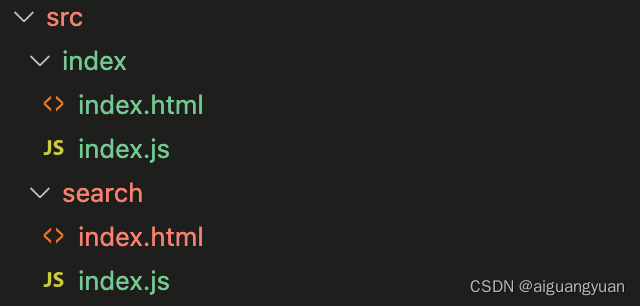Webpack实现多页面打包的方法步骤
作者:aiguangyuan
本文主要介绍了Webpack实现多页面打包的方法步骤,文中通过示例代码介绍的非常详细,对大家的学习或者工作具有一定的参考学习价值,需要的朋友们下面随着小编来一起学习学习吧
1. 多页面应用(MPA)概念
单页面在开发时会把所有的业务放在一个大的入口里面去,不同的子业务还是同一个URL地址,只不过后面的hash会有所不同。
多页面相对于单页面的区别在于,项目发布上线以后,有多个入口文件,每一次页面跳转的时候,后台服务器都会返回一个新的html文档,这种类型的网站也就是多页面网站,也叫多页应用。
多页面有什么优势呢?主要有以下两点:
1. 多个页面之间是解耦的,利于维护;
2. 多页面对SEO更加友好;
2. 多页面打包基本思路
多页面打包的基本思路在于,每个页面对应一个entry,每个页面对应一个html-webpack-plugin,但这种方式每次在新增或删除页面时需要修改webpack配置,相当麻烦。

3. 多页面打包通用方案
1. 多个页面的文件名统一取名index,通过不同的文件夹来区分;
2. 动态获取 entry 和设置 html-webpack-plugin 数量;

4. 多页面打包实现
4.1. 安装插件;
npm i glob -D
4.2. 配置Webpack文件;
'use strict';
// 引入插件
const glob = require('glob');
const path = require('path');
const webpack = require('webpack');
// 页面打包插件
const HtmlWebpackPlugin = require('html-webpack-plugin');
// 自动清理插件
const CleanWebpackPlugin = require('clean-webpack-plugin');
// 优化控制台输出
const FriendlyErrorsWebpackPlugin = require('friendly-errors-webpack-plugin');
// 动态计算多页面打包
const setMPA = () => {
const entry = {};
const htmlWebpackPlugins = [];
// 获取本地按规则修改好的文件
const entryFiles = glob.sync(path.join(__dirname, './src/*/index.js'));
Object.keys(entryFiles).map((index) => {
const entryFile = entryFiles[index];
// 'my-project/src/index/index.js'
const match = entryFile.match(/src\/(.*)\/index\.js/);
// 获取页面文件名
const pageName = match && match[1];
entry[pageName] = entryFile;
// 根据本地定义的页面文件数量来定义htmlWebpackPlugin
htmlWebpackPlugins.push(
new HtmlWebpackPlugin({
template: path.join(__dirname, `src/${pageName}/index.html`),
filename: `${pageName}.html`,
chunks: [pageName],
inject: true,
minify: {
html5: true,
collapseWhitespace: true,
preserveLineBreaks: false,
minifyCSS: true,
minifyJS: true,
removeComments: false
}
})
);
});
return {
entry,
htmlWebpackPlugins
}
}
const { entry, htmlWebpackPlugins } = setMPA();
module.exports = {
// 入口文件
entry: entry,
// 输出文件
output: {
path: path.join(__dirname, 'dist'),
filename: '[name].js'
},
// 开发模式
mode: 'development',
module: {
rules: [
{
test: /.js$/,
use: 'babel-loader'
},
{
test: /.css$/,
use: [
'style-loader',
'css-loader'
]
},
{
test: /.less$/,
use: [
'style-loader',
'css-loader',
'less-loader'
]
},
{
test: /.(png|jpg|gif|jpeg)$/,
use: [
{
loader: 'url-loader',
options: {
limit: 10240
}
}
]
},
{
test: /.(woff|woff2|eot|ttf|otf)$/,
use: 'file-loader'
}
]
},
plugins: [
// 热更新插件
new webpack.HotModuleReplacementPlugin(),
// 自动清理插件
new CleanWebpackPlugin(),
// 简化打包控制台输出
new FriendlyErrorsWebpackPlugin()
].concat(htmlWebpackPlugins),
// 热更新相关配置
devServer: {
// 基本目录
contentBase: './dist',
// 热更新
hot: true,
// 只输出报错
stats: 'errors-only'
},
devtool: 'cheap-source-map'
};到此这篇关于Webpack实现多页面打包的方法步骤的文章就介绍到这了,更多相关Webpack 多页面打包内容请搜索脚本之家以前的文章或继续浏览下面的相关文章希望大家以后多多支持脚本之家!
